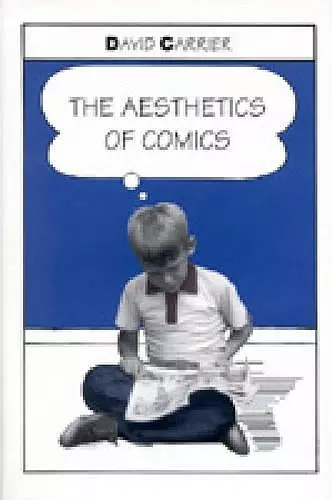The Aesthetics of Comics
Format:Hardback
Publisher:Pennsylvania State University Press
Currently unavailable, and unfortunately no date known when it will be back
This hardback is available in another edition too:
- Paperback£29.95(9780271021881)

From Gary Larson’s The Far Side to George Herriman’s Krazy Kat, comic strips have two obvious defining features. They are visual narratives, using both words and pictures to tell stories, and they use word balloons to represent the speech and thought of depicted characters. Art historians have studied visual artifacts from every culture; cultural historians have recently paid close attention to movies. Yet the comic strip, an art form known to everyone, has not yet been much studied by aestheticians or art historians. This is the first full-length philosophical account of the comic strip.
Distinguished philosopher David Carrier looks at popular American and Japanese comic strips to identify and solve the aesthetic problems posed by comic strips and to explain the relationship of this artistic genre to other forms of visual art. He traces the use of speech and thought balloons to early Renaissance art and claims that the speech balloon defines comics as neither a purely visual nor a strictly verbal art form, but as something radically new. Comics, he claims, are essentially a composite art that, when successful, seamlessly combine verbal and visual elements.
Carrier looks at the way an audience interprets comics and contrasts the interpretation of comics and other mass-culture images to that of Old Master visual art. The meaning behind the comic can be immediately grasped by the average reader, whereas a piece of museum art can only be fully interpreted by scholars familiar with the history and the background behind the painting. Finally, Carrier relates comics to art history. Ultimately, Carrier’s analysis of comics shows why this popular art is worthy of philosophical study and proves that a better understanding of comics will help us better understand the history of art.
“The ingenuity with which the classical comic strip artists found ways of telling whole stories in four or five panels has been insufficiently appreciated by philosophers or historians of art. Carrier has written a marvelous book on these narrative strategies, from which we cannot but learn something about how the mind processes pictorial information and how the Old Masters coped with the urgent stories simple people had to understand.”
—Arthur Danto, Columbia University
“Carrier is an academic philosopher who also works as an engaged commentator on contemporary art. His writings tend to be full of witty rhetorical constructions, and thus they are entertaining to read in ways that most contemporary academic writing, whether on philosophy or art or both, is not.”
—Bill Berkson, San Francisco Art Institute
“David Carrier has written a most perceptive and readable account of that great American apparatus—the comic strip. Historically accurate and philosophically bracing, this is a truly terrific book. Carrier has done a necessary and brilliant service, and he has provided a true gift to all who admire the comic strip tradition.”
—Archie Rand, Columbia University
“Carrier’s gracefully erudite book will do for the comics what Stanley Cavell has done for Hollywood movies.”
—George J. Leonard Universal Pictures
“An indispensable and enjoyable contribution to discussions dealing with the end of Modernism, the function of art history, and the will to form a healthy development beyond current mannerist, postmodern malaise.”
—Mark Staff Brandl The Art Book
ISBN: 9780271019628
Dimensions: 229mm x 152mm x 10mm
Weight: 454g
152 pages